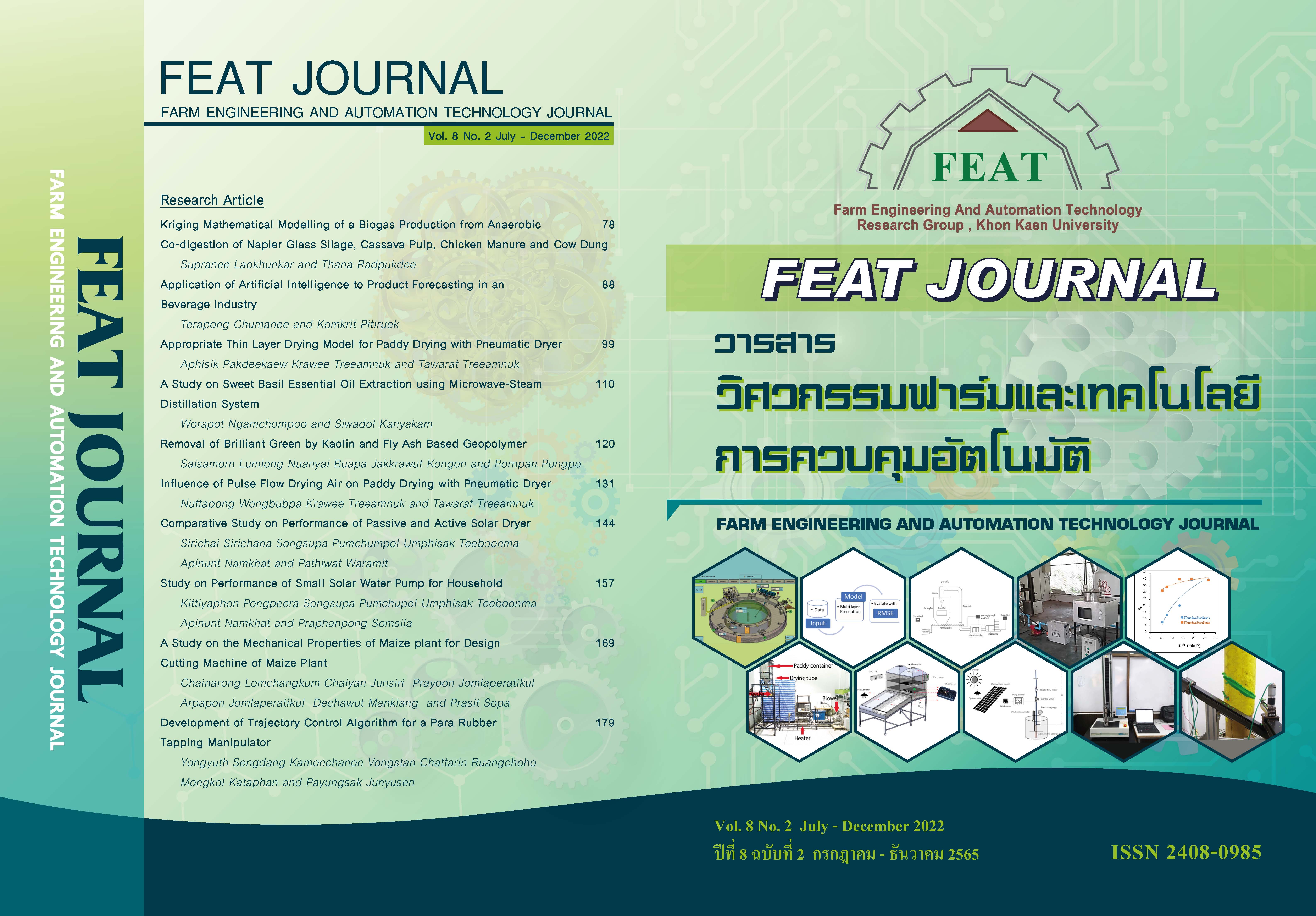การศึกษาเปรียบเทียบสมรรถนะเครื่องอบแห้งพลังงานแสงอาทิตย์ ไหลเวียนอากาศแบบธรรมชาติและแบบบังคับ
Main Article Content
บทคัดย่อ
งานวิจัยนี้ได้สร้างเครื่องอบแห้งพลังงานแสงอาทิตย์ที่มีห้องอบแห้งจำนวน 4 ห้อง เพื่อใช้ทดสอบสมรรถนะเครื่องอบแห้งพลังงานแสงอาทิตย์ไหลเวียนอากาศแบบธรรมชาติ (PSD) และเครื่องอบแห้งพลังงานแสงอาทิตย์ไหลเวียนแบบบังคับ (ASD) โดยปรับเปลี่ยนอัตราการไหลอากาศที่ใช้ใน ASD เท่ากับ 0.03 m3/s (ASD0.03), 0.06 m3/s (ASD0.06) และ 0.09 m3/s (ASD0.09) ตามลำดับ ในการศึกษานี้ได้เลือกใช้เนื้อหมูที่มีความชื้นเริ่มต้นเท่ากับ 265 เปอร์เซ็นต์มาตรฐานแห้ง เป็นตัวอย่างในการทดลอง ซึ่งมีเกณฑ์ที่ใช้ในการประเมินสมรรถนะเครื่องอบแห้งพลังงานแสงอาทิตย์ ได้แก่ อัตราการอบแห้ง ประสิทธิภาพเครื่องอบแห้งพลังงานแสงอาทิตย์ และความสิ้นเปลืองพลังงานจำเพาะ ผลการศึกษาพบว่า สมรรถนะ ASD สูงกว่า PSD นอกจากนั้นยังพบว่า อัตราการอบแห้งของเครื่อง ASD0.06 สูงกว่าอัตราการอบแห้ง PSD, ASD0.03 และ ASD0.09 เท่ากับร้อยละ 19.35, 10.52 และ 8.86 ตามลำดับ ในขณะที่ความสิ้นเปลืองพลังงานจำเพาะ ASD0.06 น้อยกว่า PSD, ASD0.03 และ ASD0.09 เท่ากับร้อยละ 26.56, 17.13 และ 15.65 ตามลำดับ และสุดท้ายยังพบว่าประสิทธิภาพเครื่องอบแห้งพลังงานแสงอาทิตย์ PSD, ASD0.03, ASD0.06 และ ASD0.09 มีค่าเท่ากับร้อยละ 11.68, 12.68, 14.91 และ 12.91 ตามลำดับ
Article Details

อนุญาตภายใต้เงื่อนไข Creative Commons Attribution-NonCommercial-NoDerivatives 4.0 International License.
วารสารวิศวกรรมฟาร์มและเทคโนโลยีควบคุมอัตโนมัติ (FEAT Journal) มีกําหนดออกเป็นราย 6 เดือน คือ มกราคม - มิถุนายน และ กรกฎาคม - ธันวาคม ของทุกปี จัดพิมพ์โดยกลุ่มวิจัยวิศวกรรมฟาร์มและเทคโนโลยีควบคุมอัตโนมัติ คณะวิศวกรรมศาสตร์มหาวิทยาลัยขอนแก่น เพื่อเป็นการส่งเสริมและเผยแพร่ความรู้ ผลงานทางวิชาการ งานวิจัยทางด้านวิศวกรรมศาสตร์และเทคโนโลยีพร้อมทั้งยังจัดส่ง เผยแพร่ตามสถาบันการศึกษาต่างๆ ในประเทศด้วย บทความที่ตีพิมพ์ลงในวารสาร FEAT ทุกบทความนั้นจะต้องผ่านความเห็นชอบจากผู้ทรงคุณวุฒิในสาขาที่เกี่ยวข้องและสงวนสิทธิ์ ตาม พ.ร.บ. ลิขสิทธิ์ พ.ศ. 2535
เอกสารอ้างอิง
El-sebaii AA, Shalaby SM. Solar drying of agricultural products: A review. Renewable and Sustainable Energy Reviews. 2012; 16: 37-43.
Ahmed A. Drying characteristic of apple slices undertaken the effects of passive shelf solar dryer and open sun drying. Pakistan Journal of Nutrition. 2013; 12(3): 250-4.
Ahmed AG. Design construction and performance evaluation of solar maize dryer. Journal of Agricultural Biotechnology and Sustainable Development. 2010; 23: 39-46.
Nwajinka CO and Onuegbu CU. Development of a solar cabinet dryer for root crops chips in Nigeria. Journal of Agricultural Engineering and Technology. 2014; 22(2): 47-58.
Okoroigwe EC, Eke MN and Ugwu HU. Design and evaluation of combined solar and biomass dryer for small and medium enterprises for developing countries. International Journal of Physical Sciences. 2013; 8(25): 1341-9.
Janjai S and Bala BK. Solar drying technology. Food Engineering Review. 2012; 4: 16-54.
Gutti B, Kiman S and Mustafa BG. Design and construction of forced/natural convection solar vegetable dryer with heat storage. ARPN Journal of Engineering and Applied Sciences. 2012; 7(10): 1213-7.
Hajar E, Mohammed B, Rachid T, and Bargach MN. Experimental and theoretical analysis of drying grapes under an indirect solar dryer and in open sun. Innovative Food Science and Emerging Technologies. 2018; 49: 58-64.
Muruganantham PK, Kamalakannan RS and Mohana S. Performance analysis of a tubular solar dryer for drying mexican mint (Plectranthus amboinicus) - An experimental approach. Energy Reports. 2021; 7: 7-12.
Nabnean S and Nimnuan P. Experimental performance of direct forced convection household solar dryer for drying banana. Case Studies in Thermal Engineering. 2020; 22: 1-11.
Masnaji RN and Vinod BT. A review on performance evaluation of solar dryer and its material for drying agricultural products. Materials today: Proceedings. 2021; 46(1): 345-9.
Ankur GB, Das AB and Jayanta DM. Sustainability and 4E analysis of novel solar photovoltaic-thermal solar dryer under forced and natural convection drying. Renewable Energy. 2022; 188: 1008-21.
El-Sebaii AA and Shalaby SM. Experimental investigation of an indirect-mode forced convection solar dryer for drying thymus and mint. Energy Conversion and Management. 2013; 74: 109-16.
Samira C, Abdelghani B, Djamel M and Mohamed HB. Solar drying of sliced potatoes-an experimental investigation. Energy Procedia. 2013; 36: 1276-85.
Avesahemad SN, Husainy SP and Gouri W. Experimental investigation of mixed mode forced convection solar dryer for turmeric (Curcuma Longa). Asian Review of Mechanical Engineering. 2018; 7(1): 1-6.
Baher MAA, Klaus G, Hossain MA. Integrated hybrid solar drying system and its drying kinetics of chamomile. Renewable Energy. 2018; 121: 539-47.
Semwanga M, Nakiguli F and Nasejje S. Drying performance and economic analysis of novel hybrid passive-mode and active-mode solar dryers for drying fruits in East. Journal of Stored Products Research. 2020; 88: 1-11.
Aymen E, Sami K, Ilhem H and Abdelhamid F. Experimental investigation and economic evaluation of a new mixed-mode solar greenhouse dryer for drying of red pepper and grape. Renewable Energy. 2015; 77: 1-8.
Mohamed AE, Mostafa MA and Abdulrahman OA. Solar PV powered mixed-mode tunnel dryer for drying potato chips. Renewable Energy. 2018; 116: 594-605.
Aprajeeta J and Tripathy PP. Recent advancements in design, application, and simulation studies of hybrid solar drying technology. Food Engineering Reviews. 2021; 13: 375-410.
Wei W, Ming L, Reda HE, Yunfeng W and Luwei Y. Thermal performance of indirect forced convection solar dryer and kinetics analysis of mango. Applied Thermal Engineering. 2018; 134: 310–21.
Ortiz-Rodríguez NM, Condorí M, Duran G and García-Valladares O. Solar drying technologies: A review and future research directions with a focus on agroindustrial applications in medium and large scale. Applied Thermal Engineering. 2022; 215: 1-31.


